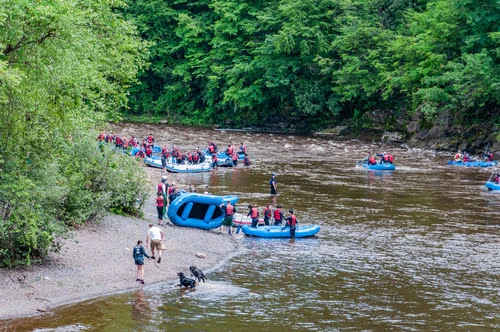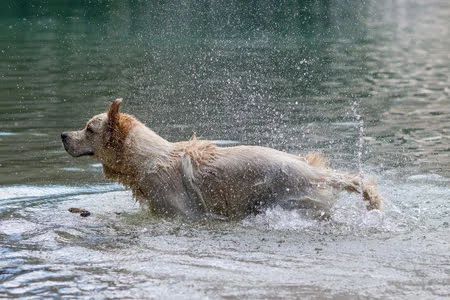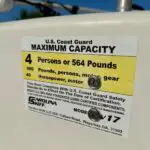We all need a little adventure and adrenaline in our lives. Whitewater rafting is a thrilling activity that gets the blood pumping and makes you feel alive.
If you are a rapids enthusiast and a dog owner who wants to bring them along for the adventure….you may be wondering, can dogs go whitewater rafting too?
It is safe?
Well, the answer is that it depends on the dog and the type of whitewater rafting trip…let me explain.
Table of Contents
- What Class of Rapids is Safe for my Dog?
- How To Keep A Dog Calm While Rafting
- Is Rafting Right For My Dog Breed?
- Tips To Make Your Dogs Comfortable Whitewater Rafting
- What To Pack
- Safety First
- Conclusion
- Related Posts
What Class of Rapids is Safe for my Dog?
If you are considering taking your dog on a whitewater rafting trip, then your first step is to determine what level of rapid is right for your dog.
For a first-time rafting dog, it’s advisable to test their limits on Class I rapids. More experienced dogs can typically handle Class II rapids, with a little caution. Anything beyond Class II needs to be decided upon carefully while taking into consideration your dog’s level of experience and the specific river you plan on rafting.
Considerations
Even with a life jacket and a love for the water, dogs can get caught in a current, panic, and get seriously injured while rafting.
Dogs do not fully comprehend the dangers of whitewater and lack the ability to anticipate and dodge obstacles. This increases their risk of crashing into boulders or other hazards.

When determining what class of rapids to chase or where to raft, seriously consider the likelihood of your dog falling out of the boat.
If it’s a high chance, don’t risk it. For beginner pups, anything higher than a class 2 rapid is not advised.
One way to introduce your dog to the world of white rafting or river cruising is to take your dog on a tubing trip first.
Tubing runs are usually short and less intense, but are a great way to get your pup familiar with flowing water, rafts, current etc.
How To Keep A Dog Calm While Rafting
Worn-out pups rarely misbehave. They just don’t have the energy to get into trouble.
Before hitting the rapids with your dog, take them to a dog park to run around and burn off some energy.
If you’re in camp for the night, throw a ball or stick in a calm part of the river for a game of fetch. Take them for a long hike before dinner.
Do whatever you can to wear out your dog. The goal is to have a tired dog in the raft with you so they’re not bounding from tube to tube.
If you have an older dog who has already mellowed, then you can probably skip this part altogether.
Some other tips for taking your dog on the boat for the first time can be helpful in acclimating your dog to the water.
Is Rafting Right For My Dog Breed?
If you have a dog that can’t sit still, then you should probably leave them at home until they get a little older and calmer.
Even if your dog is properly trained, you need to think about how well they will tolerate being on a raft for most of the day.
Some dogs simply don’t do well in a confined space for long periods of time. Others will curl up and go straight to sleep.

If your dog is the latter, then congratulations, you have a quality rafting dog!
If you have a high-energy breed, then consider ways to keep your dog entertained for several hours.
A bone filled with frozen peanut butter, large chews that take time to get through, and stopping occasionally to get energy out are all good ways to enhance your dog’s boat tolerance.
Let your dog’s temperament and patience be a guide when determining how long your trip should be.
Tips To Make Your Dogs Comfortable Whitewater Rafting
In The Raft
Another thing that will greatly improve your dog’s tolerance for the raft is if you ensure they have a designated, comfortable spot to lie down.
You have a designated spot after all, why shouldn’t your dog?
Most whitewater rafts, decked out for an overnight trip, will come equipped with the perfect dog bed – the dry box. Just plop an old dog towel or sleeping pad on top of it to add a little cushion and protect your dog from the heat and you have an instant bed.
Of course, you can also just make a cozy spot for your dog on the floor of the raft, but the dry box seems to be a fan favorite.
Make sure your dog has a safe place to sleep or entertain themselves out of your way.
At The Campsite
Your dog doesn’t just need a place to rest in the raft, but also overnight to recover from a long day on the water.
Most people are fine bringing their dogs into their tents at night. If you do that, make sure that your dog has a towel or blanket to lie on if it’s cold to keep them warm.
If you want to keep your dog outside overnight at your campsite, then be sure to seal all food. Not only will this keep your dog out of it, but it will also help keep predators away from your camp and your pup as well.
Have a lead or other method of tying your dog up at night to ensure they don’t wander off into the darkness. The lead should be long enough that they can get to an area to sleep and an area far enough away to use the bathroom.
Also, be sure to have fresh water available regardless of whether they’re sleeping inside your tent or outside under the stars.
What To Pack
Your packing list for your dog will definitely be longer for an overnight adventure than for an afternoon outing.
For a comprehensive list of what to bring for dogs on a boat, we have created the ultimate dog essential packing list.
- Water and food bowl
- Food and water for the duration of the trip
- Any meds your dog might need
- Treats to reward your dog for good behavior in the raft
- Chews and toys for entertainment
- Poop bags
- Dog bed of some type
- Towels to clean off a dirty or wet dog
- Light to clip on collar for nights in camp
- Hitch system to allow dogs some safe roaming in camp
- Tweezer or tick removal tool
- First aid kit for dogs
The light to clip on your dog’s collar and the hitch or lead system are critical. First off, dogs are very hard to spot in the dark, so it’s important to have a light attached to them in case they encounter a predator or wander off.
You also need to have a good lead or hitch system in place even if your dog is staying in your tent with you overnight.
Dogs zooming around an open campfire are never a good idea. Especially, when you’re cooking dinner for a raft or two full of ravenous people.
Having a safe place to tie up your dog away from the campfire where they can happily roam out of the way isn’t just nice for the chef, your dog will appreciate it, too.
Safety First
Whitewater rafting is inherently dangerous compared to many other pastimes. Throw a dog or two into the mix, and the danger level drastically increases.
To keep everyone safe, make sure you bring along the following items:
- Dog life jacket (to be worn at all times in the raft)
- Plenty of fresh water (river water is not safe to drink)
- First aid kit
- Sun shirt or dog sunscreen
- Leash for onshore adventures
Also, be sure to make plenty of pit stops on shore for bathroom breaks and leg stretching for your dog.
It’s also nice to give your dog a chance to stretch out in the shade for a bit to get a break from the hot, cramped confines of the raft.
It should also be noted that you should never tie your dog to the raft. If the raft flips, you will not be able to untie them in time.
Lastly, once you’re in camp each evening be sure to look over your furry friend for any ticks, scratches, or other wounds that they might have picked up on the river.

Conclusion
Tired dogs are happy dogs and whitewater rafting with your best friend just might be the best way to wear them out.
Determine the appropriate class of rapids, pack accordingly, load up your dog, and hit the rapids.

Growing up in Florida, I’ve been surrounded by saltwater my entire life…and I love sharing my passion with others.
To learn more about why I started Saltwater Mecca, visit the ABOUT page.
Thank you for reading this article. Browse around & have some fun!





